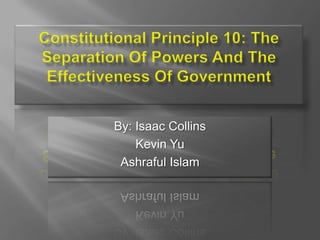
Presentation1
- 1. Constitutional Principle 10: The Separation Of Powers And The Effectiveness Of Government By: Isaac Collins Kevin Yu Ashraful Islam
- 2. Background Like Montesquieu, the framers of the constitution believed the only way to be certain of no future tyrannies was to establish a system of government which was separated into three branches: the executive, the legislative, and the judicial.
- 3. Checksand Balances: Presidential Veto Whenever a bill is being reviewed, Congress and the president dispute over its approval. If a law is proposed, the president is able to whip out his pen and reject it. However, after the president rejects the bill, Congress, with a two-thirds vote, is able to override the president’s veto, allowing the bill to become a law.
- 4. Judicial Review: Marbury vs. Madison The case involved a last minute appointment of PL Marbury as a justice of the peace, by the leaving John Adams. The new administration with Secretary of State James Madison obtained a repeal of the statute creating the courts and refused to grant Marbury’s commission. Marbury ended up suing James Madison for a write of Mandamus. The Supreme Court found that to forcibly appoint Marbury to the position goes against Article three of the Constitution.
- 5. Checks and Balances: The Treaty of Versailles The Treaty of Versailles marked the end of World War I. The final conclusions of the treaty was decided byDavid Lloyd George of Britain, Clemenceau of France, and Woodrow Wilson of America. France was harsh and unsympathetic towards Germany, who was blamed entirely for the war. Britain supported reparations but to a lesser extent than the French. Woodrow Wilson of America sought to isolate America from the issues in Europe. When Wilson returned to America, he submitted the treaty to the Senate for ratification. The Senate was skeptical towards the League of Nations Covenant. But Wilson still fought for it’s ratification. Despite Wilson’s effort, the Senate rejected the treaty by votes 38 to 53.
- 6. Checks and Balances: FDR and the Supreme Court reorganization In 1937, President Franklin Roosevelt proposed to reorganize the Supreme Court by increasing the number of justices, also known as the “court packing scheme”. Although Roosevelt lost in this particular case, this event assured the safety of New Deal programs such as the Social Security and National Labor Relation Acts. Later, Roosevelt was accused of trying to undue the legacy of checks and balances. He was denounced as a dictator that tried to enhance the presidential seat. This case was eventually dismissed and the Court took up the New Deal programs and implemented them.
- 7. The Vietnam War took place from 1945 to 1954. The Vietnamese waged anti-colonial war against the French and won. The United States backed Vietnam during this time. After the war, Vietnam separated into a communist north and an anti-communist south. The US sent in 2,000 military advisers which grew to 16,300 by 1963. Johnson escalated the war with air strikes and ground forces. With a total of 563,000 by 1968. At 1968 to 1973, efforts were made to end the conflict and the US forces were withdrawn. In 1973, Congress enacted the War Powers Act, which required that the president must receive Congressional approval before committing American forces overseas. Checks and Balances: Vietnam War
- 8. Watkins v. United States Watkins was convicted for failing to answer questions while posed as a witness relating to people he may have known to be communist. Watkins stated that he did not wish to answer these questions, because they were not related to the case he was called upon. A panel of judges decided 6 to 1 to overturn Watkins’ conviction. Earl Warren supported Watkins, saying that the congress had no authority to expose individuals’ private affairs. United States v. Nixon In 1972, Archibald Cox received a subpoena to obtain documentation of meetings held in Nixon’s office related to the Watergate break-ins. Nixon refused stating that they are confidential due to executive privilege. The Supreme Court accepted the case and Nixon had to abide by the definitive order by court
- 10. The President must notify the Congress 48 hours before deployment
- 11. If the President is not authorized or if he does not have a declaration of war he has to withdraw troops within 60 days
- 12. Permitted Congress to withdraw troops with a majority votePresident Lyndon Johnson President Richard Nixon
- 14. Limited individual contributions to candidates for federal office to $1,000, and many more.Nixon Bugs Resignation
- 15. Clinton: Impeachment and Acquittal Independent Counsel Kenneth Starr launched an investigation on President Clinton on why he fired some White House travel agents, misuse of FBI files, sexual harassment lawsuit filed against Clinton by a former intern Paula Jones, and sexual relationships with staff member Monica Lewinsky. It was ruled that Starr’s evidence contained irrelevant and pornographic description and so President Clinton was only charged with perjury and obstruction. According to the United States Constitution, Article II, Section 4, its is said that a person in government can be impeached with majority vote in The House of Representatives, and two-thirds majority in the Senate. The House of Representatives were able to impeach President Clinton, however Clinton did not get majority impeachment vote in the Senate with 55 senators voted not guilty, and 45 voted guilty on the perjury charge and 50/50 votes for the obstruction charge. US Senate during impeachment trial